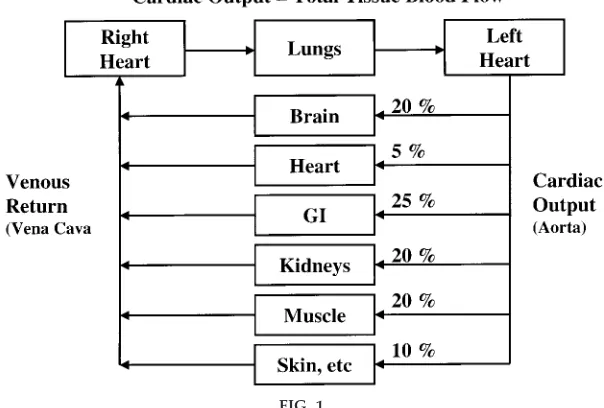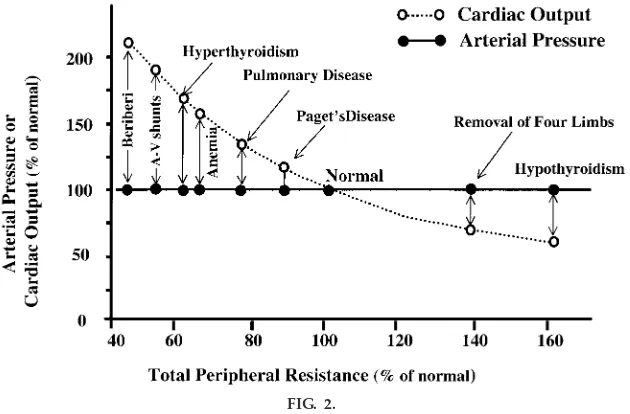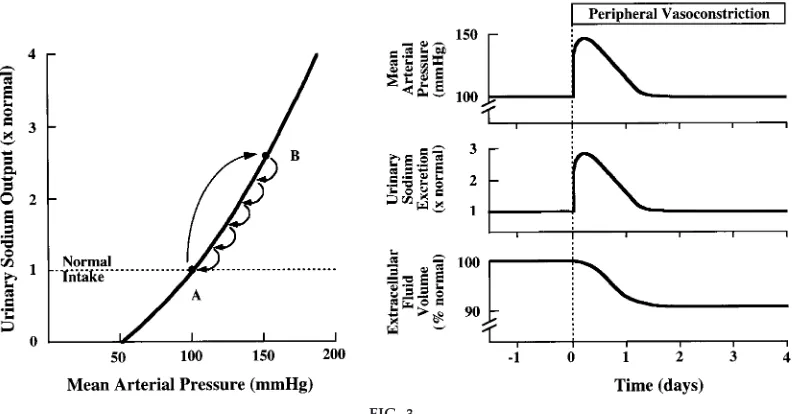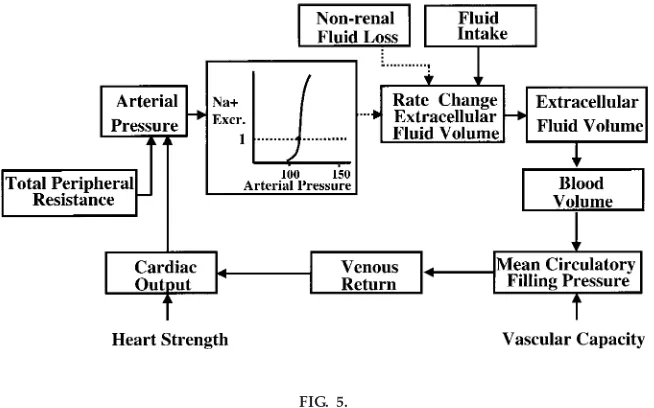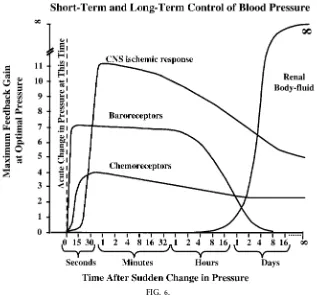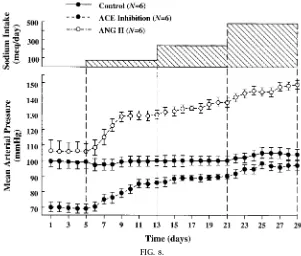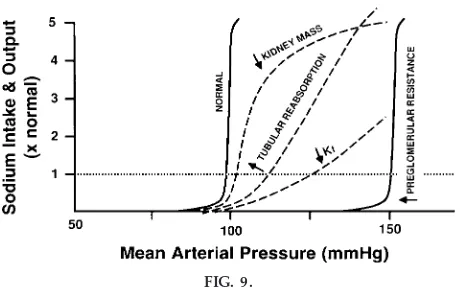INTEGRATION AND REGULATION
OF CARDIOVASCULAR FUNCTION
John E. Hall
Depa rtm ent of Physiology a nd Biophysics, University of Mississippi Medica l Center, Ja ck son, Mississippi 39216-4505
N
ew methods in molecular biology and genetics have made possible many of the dramatic advances in physiological research that have occurred in recent years. For those of us who spend most of our time in the research laboratory, it is sometimes difficult to avoid a research-oriented, reductionist mind-set when discussing physiology with students. This article illustrates, with a few examples, the importance of conveying a ‘‘big picture’’ conceptual framework before discussing the details of cardiovascular physiology. Also, I have chosen examples from cardiac output and blood pressure regulation that show the importance of discussing cardiovascular physiology in terms of feedback control systems and integrating information from other areas, such as renal and endocrine physiology. Finally, I have highlighted the importance of two principles that I believe are often underemphasized in teaching physiology: mass balance and time dependence of physiological control systems.AM. J. PHYSIOL. 277 (ADV. PHYSIOL. EDUC. 22): S174–S186, 1999.
Key words:cardiac output; blood flow; arterial pressure; kidney; pressure natriuresis; angiotensin; aldosterone; hypertension; heart failure; cirrhosis
...It is our ha bit to try to a pproa ch the expla na tion of a physica l process by splitting this process into its elem ents. We rega rd a ll com plica ted processes a s com bina tion of elem enta ry processes... tha t is, we think of the whole before us a s a sum of its pa rts. But this presupposes tha t the splitting of the whole does not a ffect the cha ra cter of the whole.—Ma x Pla nck
Although Max Planck was the ultimate reductionist, he clearly recognized that complex systems are much more than the sum of their individual parts. In his lectures on theoretical physics, Planck eloquently emphasized that splitting the whole, particularly with irreversible processes, usually changes the character of the process. I believe that we can assume that this is also true of the human body where the heart does not function in isolation of the blood vessels, the kidneys, or the neurohumoral systems. Attempts to reconstruct
living organisms from their individual parts, or even to comprehend the function of a complex component such as the cardiovascular system, by studying only the individual subsystems (e.g., molecules, cells, or organs) have been uniformly unsuccessful (9).
Many recent discoveries in physiology have come from a reductionist approach, using methods from the fields of genetics and molecular physiology, and we often carry this mind-set into our teaching, although most physiologists understand the importance of integration and regulation. I will not attempt to provide an overview of how to teach integration and regulation of cardiovascular function (this is available in textbooks such as Ref. 3) or to discuss in detail the value of integrative physiology (elegant reviews, such as Ref. 9, have already discussed this topic). I have the more modest goal of illustrating, with a few examples related to
regula-1043 - 4046 / 99 – $5.00 – COPYRIGHTr1999 THEAMERICAN PHYSIOLOGICAL SOCIETY
VOLUME22 : NUMBER 1 –AD VAN CES I N PH YSI O LO GY ED U CATI O N– DECEMBER 1999
tion of cardiac output and arterial pressure, the impor-tance of providing an overall conceptual framework when discussing cardiovascular physiology with students.
CARDIAC OUTPUT REGULATION
Let’s begin by asking a very simple question.
Which of the following cha nges in ca rdia c output would you expect to find seven da ys a fter surgica l reduction of k idney m a ss by 50% (rem ova l of one k idney): a n increa se, a decrea se, or no cha nge?
When I asked this question at the Experimental Biology ’99 symposium, most of the audience (which included primarily physiologists) answered either ‘‘no change’’ or ‘‘an increase,’’ even though the correct answer is a decrease in cardiac output. Why is cardiac output reduced by removal of a kidney when there has been no obvious effect on cardiac pumping ability or heart rate? This is not easy to comprehend if one thinks in a ’cardiocentric’ manner and focuses on the well-known formula learned by all physiologists: car-diac output5stroke volume3heart rate.
Car diac Output is the Sum of Tissue and Or gan Blood Flows
If I had shown Fig. 1 before asking this question, I doubt that anyone would have had difficulty
answer-ing it. The reason for the decrease in cardiac output after unilateral nephrectomy is that, except for momen-tary imbalances, cardiac output is equal to venous return, which is equal to the sum of the flows of all of the individual tissues and organs. Removing one kidney decreases blood flowing back to the heart by ,10% (assuming that total flow to both kidneys is
,20% of the cardiac output). The same effect would be observed with amputation of an arm or a leg or with removal of any other tissue from the body. This example illustrates that cardiac output is determined not only by the function of the heart but also by the peripheral circulation. Except when the heart is severely weakened and unable to adequately pump the venous return, cardiac output (total tissue blood flow) is determined mainly by the metabolic needs of the tissues and organs of the body, although intrinsic and neurohumoral mechanisms allow the heart to effectively accommodate changes in venous return.
This conceptual framework is very helpful in explain-ing changes in cardiac output that occur durexplain-ing exercise (when metabolic activity and blood flow to skeletal muscles are increased), after eating a large meal (which increases metabolic activity and blood flow in the gastrointestinal system), and in many other physiological conditions. In each of these circum-stances, cardiac pumping ability plays a relatively
FIG. 1.
permissive role and cardiac output is increased be-cause of increased tissue blood flow.
Tissue Blood Flow Autor egulation and Car diac Output
A second question illustrates the importance of inte-grating the principles of tissue blood flow regulation in discussing cardiac output.
If ca rdia c output regula tion is the sum of a ll loca l blood flow regula tions, why is ca rdia c output not significa ntly a ltered in pa thophysiologica l condi-tions a ssocia ted with increa sed levels of powerful va soconstrictors such a s a ngiotensin II (ANG II)? Also, why does va sodila tor thera py in hypertensive pa tients usua lly fa il to increa se ca rdia c output?
To answer these questions, we must consider one of the most fundamental principles of circulatory func-tion: the ability of each tissue to autoregulate its own blood flow according to its metabolic needs and other functions necessary. Administration of a powerful vasoconstrictor such as ANG II may cause a transient decrease in cardiac output, but it has little long-term effect because it does not alter the metabolic rate of most tissues. Likewise, most vasodilators cause only short-term changes in tissue blood flow and cardiac output.
Therefore, to effectively explain cardiac output regula-tion, it is necessary to discuss the mechanisms that control blood flow in the different tissues (1, 3). Local blood flow regulation, as is true for most physiological controls, involves short-term and long-term mecha-nisms. Acute control occurs within seconds or min-utes via constriction or dilation of the vasculature. After administration of a vasoconstrictor that does not alter metabolic rate of the tissues, there is a transient mismatch between the supply of nutrients and meta-bolic need of the tissues, and as a result there is a relative deficiency of nutrients (e.g., oxygen) and an accumulation of metabolic waste products. This, in turn, causes vasodilation and a return of tissue blood flow toward normal. In some tissues in which blood flow regulation is not determined mainly by metabolic needs, such as the kidney, ANG II may cause a small, sustained decrease in blood flow that barely alters cardiac output. Other short-term controls, such as the myogenic response, also raise vascular resistance in
response to increased blood pressure and help to autoregulate blood flow in the different tissues.
Long-term blood flow regulation takes place over several days or weeks and involves structural changes in the blood vessels, such as thickening of vessel walls and decreased numbers of capillaries (rarefaction) in response to chronic increases in blood pressure. Together, the short-term and long-term mechanisms maintain the required levels of blood flow in each tissue to ensure normal tissue function. In most physiological conditions the cardiac output reflects mainly the sum of these control mechanisms for blood flows in the different tissues of the body.
Unfortunately, these simple interrelationships be-tween the peripheral circulation and the heart are often not emphasized, and, as a result, students (and physiologists) have difficulty in explaining cardiac output regulation under many physiological and patho-physiological conditions. Of course, study of cardiac pumping ability is also essential in understanding cardiac output regulation, especially in conditions such as heart failure. However, it is very helpful to first discuss the factors that control local blood flows before discussing cardiac output regulation.
ARTERIAL PRESSURE REGULATION
Control of arterial pressure provides another example of the importance of providing an integrative concep-tual framework. Blood pressure regulation is often discussed in terms of the various factors that influence cardiac pumping or vascular resistance because of another formula: mean arterial pressure 5 cardiac output3total peripheral resistance. This conceptual framework, with the addition of factors that influence vascular capacity and transcapillary exchange, is ad-equate to explain short-term blood pressure regula-tion, but it presents some difficulties when discussing abnormalities of long-term blood pressure regulation, such as hypertension, the most common cardiovascu-lar disorder seen in clinical practice.
Consider another question to illustrate this point.
Wha t cha nges in blood pressure, ca rdia c output, a nd extra cellula r fluid volum e would you expect to find seven da ys a fter a 50% increa se in tota l periphera l
VOLUME 22 : NUMBER 1 –AD VAN CES I N PH YSI O LO GY ED U CATI O N – DECEMBER 1999
va scula r resista nce (TPR) ca used by surgica l closure of a la rge a rteria l-venous (A-V) fistula ?
In this case, cardiac pumping ability is not directly altered and TPR is chronically increased by 50%. Again, when I posed this question to an audience of physiologists, more than one-half believed that an increase in TPR would cause a chronic (.7 days) increase in arterial pressure. The correct answer, however, is that closure of an A-V fistula would cause no chronic change in arterial pressure despite a sustained increase in TPR.
Likewise, increasing TPR by amputation of a limb or hypothyroidism (which reduces metabolic rate of the tissues and increases vascular resistance), or decreas-ing TPR by creatdecreas-ing an A-V fistula, anemia, or hyperthy-roidism, fails to have a significant long-term effect on arterial pressure (Fig. 2). Why do these large chronic changes in TPR not have a significant long-term effect on arterial pressure?
Figure 3 shows what actually happens when TPR is increased by closure of an A-V fistula or any other disturbance that increases TPR without altering renal
excretory capability. Initially, the increased vascular resistance raises arterial pressure, but at the same time the elevated arterial pressure also raises urinary so-dium excretion because of pressure natriuresis. As long as sodium excretion exceeds sodium intake, extracellular fluid volume and cardiac output will decrease until arterial pressure eventually returns to normal. Thus, to explain long-term blood pressure regulation in these circumstances, we must consider another system, the renal-body fluid feedback, and introduce two other concepts:1) time dependency of blood pressure control mechanisms and2) the neces-sity of maintaining balance between intake and output of water and electrolytes.
Renal-Body Fluid Feedback is a Dominant Mechanism for Long-Ter m Blood
Pr essur e Regulation
Figure 4 shows the conceptual framework for under-standing long-term control of blood pressure by the renal-body fluid feedback mechanism. Extracellular fluid volume is determined by the balance between intake and excretion of salt and water by the kidneys. Even a temporary imbalance between intake and
FIG. 2.
output can lead to a change in extracellular volume and potentially a change in arterial pressure. Under steady-state conditions there must always be a precise balance between intake and output; otherwise, there would be continuous accumulation or loss of fluid, leading to complete circulatory collapse within a few days. To maintain this precise balance, the body has several powerful feedback systems that control renal excretion of salt and water. Two of the most impor-tant mechanisms for maintaining fluid balance are the renin-angiotensin-aldosterone system and the effect of arterial pressure on renal excretion, often called pressure natriuresis (2, 4). Unfortunately, these mecha-nisms are usually discussed in the renal section of medical physiology and often are not applied in understanding cardiovascular regulation.
Figure 5 shows a simplified block diagram of the renal-body fluid feedback, emphasizing the integrative relationships between cardiac, vascular, and renal function in control of arterial pressure and extracellu-lar fluid volume. A central component of this feedback is pressure natriuresis, the effect of increased blood pressure to raise the excretion of salt and water. Under most conditions this mechanism acts to stabi-lize arterial pressure and body fluid volumes. For
example, when arterial pressure is increased above the renal set point, because of increased TPR or increased cardiac pumping ability, this also increases sodium and water excretion via pressure natriuresis if kidney function is not impaired. As long as fluid excretion exceeds fluid intake, extracellular fluid volume will continue to decrease, reducing venous return and cardiac output, until arterial pressure returns to normal and fluid balance is reestablished.
One of the major reasons for the effectiveness of the chronic pressure natriuresis mechanism in stabilizing arterial pressure is that suppression of multiple neuro-humoral antinatriuretic systems, especially the renin-angiotensin system (RAS), amplifies the direct hydrau-lic effects of pressure on sodium excretion (discussed below). An important feature of this mechanism often not appreciated is that it continues to operate until blood pressure returns to the original set point, which is determined by multiple intrinsic and neurohumoral mechanisms. In other words, it acts as an infinite gain feedback control system (2). As far as we know, it is the only infinite gain feedback system for blood pressure regulation in the body, and it is this property that makes it a dominant long-term controller of blood pressure.
FIG. 3.
Long-ter m effects of incr eased TPR, such as that caused by closur e of a lar ge A-V fistula, with no change in the r enal-pr essur e natriur esis r elationship. Blood pr essur e is initially incr eased fr om
point Ato point B, but elevated blood pr essur e cannot be sustained because sodium ex cr etion ex ceeds intake, r educing ex tracellular fluid volume until blood pr essur e r etur ns to nor mal and sodium balance is r eestablished. [Modified fr om Hall et al. (6).]
VOLUME 22 : NUMBER 1 –AD VAN CES I N PH YSI O LO GY ED U CATI O N – DECEMBER 1999
FIG. 4.
Conceptual framework for long-ter m r egulation of arterial pr essur e.
FIG. 5.
Returning to Fig. 3, we can see the infinite gain characteristic of this feedback system. In this case, arterial pressure is increased without a change in pressure natriuresis, as would occur with increased TPR due to closure of an A-V fistula, coarctation of the aorta below the kidneys (aortic coarctation above the kidneys causes marked hypertension), or other changes that increase peripheral vascular resistance without influencing renal vascular resistance. Note that the peripheral constriction initially increases blood pres-sure from point Ato point B, but the rise in blood pressure cannot be sustained because as long as pressure natriuresis is unaltered, sodium excretion will increase above intake, thereby reducing extracel-lular fluid volume until blood pressure eventually returns all the way back to normal. In fact, the normal blood pressure is the only point at which sodium and water balance can be maintained. Likewise, distur-bances that decrease peripheral vascular resistance or alter cardiac function without influencing pressure natriuresis have no long-term effect on arterial pres-sure. For long-term changes in blood pressure to occur, such as in chronic hypertension, there must be a shift of pressure natriuresis.
Feedback Contr ol Systems for Blood Pr essur e ar e Time Dependent
Physiological control systems are often considered as if they were static, and time dependency is usually not discussed. Short-term control mechanisms are empha-sized to a greater degree than long-term controls, probably because they have been studied much more extensively and are easier to explain, even though most cardiovascular diseases involve abnormalities of long-term regulation. Typically, most of the discussion of blood pressure regulation focuses on the auto-nomic nervous system, hormonal vasoconstrictors and vasodilators, and local control mechanisms that acutely influence cardiac and vascular function.
If we examine the maximal feedback gain of these different mechanisms in buffering disturbances in arterial pressure, it is obvious that their importance is highly time dependent (Fig. 6). For example, the arterial baroreceptors are extremely powerful in buff-ering changes in blood pressure over a period of seconds or minutes, but they rapidly adapt to sus-tained changes in arterial pressure and, as a result, are much less important in long-term blood pressure
regulation. On the other hand, the renal-body fluid feedback is unimportant in acute blood pressure control but becomes extremely powerful over a period of several days.
Neur ohumoral Mechanisms Modulate Pr essur e Natriur esis and Long-Ter m Blood Pr essur e Regulation
There are many factors that influence the kidney’s ability to excrete salt and water and, therefore, sure natriuresis and long-term control of arterial pres-sure. Excessive activation of antinatriuretic systems, such as the RAS and sympathetic nervous system, causes salt and water retention and increased blood pressure, whereas activation of natriuretic systems, such as nitric oxide and atrial natriuretic peptide (ANP), enhances pressure natriuresis and reduces arterial pressure. Some of these systems are quantita-tively much more important than others, but all exert their long-term effects on blood pressure not primarily through their effects on TPR but by altering the renal-pressure natriuresis relationship.
For example, the RAS is one of the body’s most powerful mechanisms for long-term control of arterial pressure mainly because of its powerful effects on renal sodium and water excretion and pressure natri-uresis. Figure 7 shows the effect of blocking the RAS or infusion of ANG II on the chronic pressure natriure-sis curve (7). Note that the normal curve is extremely steep so that large changes in sodium excretion, in response to variations in sodium intake, can be achieved with minimal changes in arterial pressure. One of the main reasons the normal curve is so steep is that ANG II is usually suppressed when sodium intake is raised. When ANG II levels are prevented from being suppressed, by infusion of constant amounts of ANG II (shown in Fig. 7), blood pressure becomes very salt sensitive and progressively higher blood pressures are required to maintain sodium and water balance as intake is raised. Conversely, drugs that block ANG II formation cause a leftward shift of pressure natriuresis so that sodium and water balance can be maintained at lower blood pressures, espe-cially when sodium intake is low, and this provides the basis for their potent long-term antihypertensive action.
VOLUME 22 : NUMBER 1 –AD VAN CES I N PH YSI O LO GY ED U CATI O N – DECEMBER 1999
Figure 8 shows the same concept another way. Here we see the effect of progressively raising sodium intake from very low levels of 5 meq/day to extremely high levels of 500 meq/day on mean arterial pressure in normal control dogs, in dogs in which ANG II levels are prevented from being suppressed as sodium in-take is raised, and in dogs treated with an angiotensin-converting enzyme (ACE) inhibitor (7). Note that in normal dogs, these large variations in sodium intake are accompanied by minimal changes in blood pres-sure. In other words, blood pressure is relatively insensitive to changes in salt intake under normal conditions. However, when ANG II levels are pre-vented from being suppressed by continuous infusion of ANG II to keep blood concentrations relatively constant, the same increases in sodium intake are accompanied by much larger increases in blood pres-sure. Thus the normal ability to modulate ANG II formation appropriately is one of the most important factors known to enhance the effectiveness of
pres-sure natriuresis mechanism and to permit sodium balance to be maintained with minimal changes in blood pressure.
Returning to the renal-body fluid feedback conceptual framework (Fig. 5), we can see that increases in sodium and water intake tend to increase extracellular fluid volume, venous return, cardiac output, and arterial pressure, but as long as the RAS and pressure natriuresis mechanism are functioning normally, only minimal changes in blood pressure are required to achieve sodium and water balance through pressure natriuresis.
Of course, the integrated responses to high sodium intake involves more than just the RAS. Other antinatri-uretic systems, such as aldosterone, are also sup-pressed, and there is increased formation of various natriuretic hormones, such as ANP, help to maintain sodium balance with minimal changes in blood
pres-FIG. 6.
sure (8). However, these systems play a much lesser role than the RAS (4). With this general framework in mind, we can examine blood pressure regulation in other physiological and pathophysiological condi-tions.
Chr onic Hypertension is a Compensatory Response for Impair ed Renal
Pr essur e Natriur esis
In all forms of hypertension studied thus far, there is a shift of the pressure natriuresis mechanism toward higher blood pressures that tends to decrease renal excretion of sodium and water (6). This, in turn, sets off a chain of events that increases blood pressure, and the rise in blood pressure then helps to return renal excretion to normal, reestablishing sodium balance.
There are many abnormalities that can impair renal function and shift pressure natriuresis, including loss of functional nephrons and decreased kidney mass due to renal diseases, reduction of the glomerular capillary filtration coefficient due to glomerular injury, increases in tubular reabsorption due to excess
aldoste-FIG. 7.
Steady-state r elationships between arterial pr essur e and sodium intake and ex cr etion under nor mal condi-tions with a functional r enin-angiotensin system (con-tr ol), after blockade of ANG II for mation with an angiotensin-converting enzyme (ACE) inhibitor, and after infusion of ANG II at a low dose (5 ng.kg21.min21)
to pr event ANG II levels fr om being suppr essed when sodium intake was raised. Data ar e means 6 SE. [Modified fr om data in Hall et al. (7).]
FIG. 8.
Changes in mean arterial pr essur e during chr onic changes in sodium intake in nor mal contr ol dogs, after ACE inhibition, or after ANG II infusion (5 ng.kg21.min21). [Modified fr om data in Hall et al. (7).]
VOLUME 22 : NUMBER 1 –AD VAN CES I N PH YSI O LO GY ED U CATI O N – DECEMBER 1999
rone or ANG II, or increases in preglomerular resis-tance, such as occurs with renal artery stenosis or excessive vasoconstriction of the kidney (Fig. 9). Each of these disturbances causes a slightly differ-ent effect on pressure natriuresis that can lead to salt-sensitive hypertension if the slope of pressure natriuresis is reduced or salt-insensitive hypertension if there is a parallel shift of pressure natriuresis, such as occurs with increased preglomerular resistance (6). However, in all cases, a shift of pressure natriuresis impairs the ability of the kidney to excrete sodium and water, and this necessitates an increase in arterial pressure to maintain sodium and water balance. With this conceptual approach, hypertension occurs as a compensatory response that permits sodium and wa-ter balance to maintain despite impaired kidney func-tion.
The extreme importance of these interrelationships between the kidney, sodium excretion, body fluid volumes, and arterial pressure is difficult to appreciate without integrating important information from renal, endocrine, and cardiovascular physiology. Almost all students can quickly recite the isolated effects of ANG II, aldosterone, or other hormones on kidney function and blood pressure. Likewise, almost every student can easily appreciate pressure natriuresis. However, putting these different pieces of information together into a conceptual framework is often a challenge.
Another question will illustrate the importance of integrating different areas of physiology as well as the concepts of time dependence and mass balance.
Which of the following cha nges would you expect to find in a pa tient with chronic excess a ldosterone secretion? A) decrea sed sodium excretion, B) in-crea sed a rteria l pressure, C) inin-crea sed extra cellula r fluid volum e, D) B a nd C (increa sed a rteria l pres-sure a nd increa sed extra cellula r fluid volum e), or E) a ll of these responses.
Many students will answerEbecause they know that aldosterone causes decreased sodium excretion, in-creased arterial pressure, and inin-creased extracellular fluid volume. Although this is true, they often do not appreciate the fact that the elevation in blood pres-sure returns sodium excretion to normal within a few days via pressure natriuresis so that sodium and water balance are achieved. It is important to emphasize that regardless of the level of antinatriuretic hormones or the degree of impairment of kidney function, precise balance between intake and output of salt and water must be achieved to maintain life. When renal excre-tory function is markedly impaired, this balance is often achieved at the expense of elevated blood pressure.
A good example is hypertension caused by excess aldosterone (Conn’s syndrome). If one infuses aldoste-rone at a rate that mimics plasma concentrations found in patients with primary aldosteronism, there is usually a transient decrease in sodium excretion followed by ‘‘escape’’ from sodium retention as hyper-tension develops. Although this ‘‘escape’’ has been traditionally explained by increased formation of vari-ous natriuretic systems stimulated by volume expan-sion, such as ANP, it appears to be due mainly to the rise in blood pressure and the resultant pressure natriuresis (5).
If the rise in renal perfusion pressure is prevented during chronic aldosterone hypertension, by servo-controlling renal perfusion pressure with a clamp placed on the aorta just above the kidneys, the kidneys cannot escape from sodium retention, and there is a continued increase in sodium balance with the even-tual development of severe circulatory congestion within just a few days (Fig. 10). This is similar to the
FIG. 9.
Steady-state r elationships between arterial pr essur e and urinary sodium ex cr etion and intake for subjects with nor mal kidneys and four general types of r enal dysfunction that cause hypertension: decr eased kid-ney mass, incr eased r eabsorption in distal and collect-ing tubules, r eductions in glomerular capillary filtra-tion coefficient (Kf), and incr eased pr eglomerular
failure to escape from sodium retention in severe congestive heart failure when the heart is too weak to raise blood pressure high enough to overcome sodium retention and to reestablish sodium balance. When renal pressure is allowed to rise to a hypertensive level and aldosterone infusion is continued, there is an immediate escape with a restoration of sodium bal-ance and a reduction in pressure to a lower, but still hypertensive level.
Thus, in aldosterone hypertension, the sodium reten-tion plays a dominant role in raising blood pressure, and the rise in renal artery pressure is essential in counterbalancing the antinatriuretic effects of aldoste-rone and restoring sodium balance. The same is true for all other forms of hypertension that have been studied thus far, including ANG II hypertension, vasopressin hypertension, norepinephrine hyperten-sion, and human essential hypertension (6).
FIG. 10.
Effects of chr onic aldoster one infusion when r enal per fusion pr essur e was servo-contr olled or allowed to incr ease (contr ol). When r eal per fusion pr essur e was pr evented fr om incr easing, ‘‘escape’’ fr om sodium r etention did not occur and cumulative sodium balance and systemic arterial pr essur e continued to incr ease. [Modified fr om data in Hall et al. (5).]
VOLUME 22 : NUMBER 1 –AD VAN CES I N PH YSI O LO GY ED U CATI O N – DECEMBER 1999
Conditions That Cause Incr eased Ex tracellular Fluid Volume But Nor mal Blood Pr essur e
Although chronic hypertension is invariably associ-ated with impaired renal excretory function and resetting of pressure natriuresis, there are many patho-physiological conditions associated with marked so-dium retention and increased extracellular fluid vol-ume but normal arterial pressure. Conditions associated with circulatory depression and a tendency toward low blood pressure cause sodium retention as a compensatory response that minimizes the decreased arterial pressure. In each case, the renal-body fluid feedback conceptual framework is very helpful in explaining the changes in renal excretion, extracellu-lar fluid volume, and circulatory dynamics.
Heart failur e.After a myocardial infarction or other insult to the heart (e.g., valvular damage, etc.), there is a reduction in cardiac pumping ability that initially reduces cardiac output and arterial pressure. This tends to cause sodium and water retention, and activation of various antinatriuretic systems (e.g., the RAS and sympathetic nervous system) amplifies the effect of decreased pressure to cause further sodium retention. This, in turn, raises extracellular fluid vol-ume and cardiac filling pressures and helps to restore cardiac output and arterial pressure toward normal if the initial insult is not too severe. Therefore, a relatively normal blood pressure is maintained despite impaired cardiac pumping ability but at the expense of increased circulatory volume, high cardiac filling pressures, and impaired ability to raise cardiac output during exercise. If the heart is greatly weakened, cardiac output may not increase sufficiently to return arterial pressure to normal and underperfusion of the kidneys will cause continued sodium and water reten-tion until the person develops severe circulatory congestion.
Incr eased vascular capacity.The same conceptual framework can be used to analyze the effect of increased vascular capacity caused, for example, by large varicose veins or by normal pregnancy, which increases vascular capacity because of the additional blood supply to the uterus and placenta. Increased vascular capacity would initially tend to reduce mean circulatory filling pressure, cardiac output, and arterial
pressure (see Fig. 5). From this point forward, the same responses of the renal-body fluid feedback are set into motion as for heart failure, and eventually blood volume is increased and cardiac output and blood pressure are maintained at a normal level despite increased vascular capacity.
Liver cirrhosis.A third example in which the renal-body fluid conceptual framework is helpful in explain-ing the integrated cardiovascular and renal changes is cirrhosis of the liver. In cirrhosis, plasma colloid osmotic pressure is decreased due to impaired synthe-sis of plasma proteins and large amounts of fibrous tissue in the liver impede the flow of portal blood through the liver, raising capillary pressure in the portal circulation and causing leakage of fluids and protein into the peritoneal cavity. The high pressures in the portal venous circulation also stretch the veins and increase vascular capacity. These changes all tend to reduce mean circulatory filling pressure, cardiac output, and arterial pressure and therefore set into motion the same compensations that occur in heart failure, including marked sodium and water retention by the kidneys. Eventually, if the initial disturbance is not too severe, blood pressure and cardiac output are regulated near normal despite the leakage of large amounts of fluid from the circulation and severe interstitial edema.
These are just a few examples that I hope will emphasize the importance of integrating the concepts that we teach in different areas of physiology. Provid-ing a conceptual framework makes integration much easier. Two major concepts that I believe are often underemphasized in teaching physiology are mass balance and time dependence of physiological control systems. Understanding the principle of mass balance is important in virtually all aspects of cardiovascular physiology, including cardiac output regulation, in which one has to first appreciate that cardiac output is the sum of all of the flows of the individual tissues, and long-term blood pressure regulation, in which arterial pressure may be adjusted to maintain balance be-tween intake and output of salt and water.
mechanisms were static, and their quantitative impor-tance in short-term and long-term blood pressure regulation is usually not discussed. Computer simula-tions are very helpful in this regard, and in our Medical Physiology course we use extensively a program called QCP (Quantitative Circulatory Physiology) devel-oped by Tom Coleman in our department. Finally, I believe that in our enthusiasm for new research advances we sometimes include too many unneces-sary details and complexities that can be an impedi-ment to learning the fundaimpedi-mental principles of cardio-vascular regulation. Sometimes less is more.
Everything should be a s sim ple a s possible, but not sim pler.—Albert Einstein
I gratefully acknowledge my own physiology teachers, especially Drs. Arthur Guyton (postdoctoral mentor), James Schwinghamer (graduate mentor), and Keith Ewing (undergraduate mentor), who clearly conveyed the beauty and excitement of physiology to their students.
Research support for some of the work quoted in the article came from National Heart, Lung, and Blood Institute Grant PO1-HL-51971.
Address for reprint requests and other correspondence: J. E. Hall, Dept. of Physiology and Biophysics, Univ. of Mississippi Medical Center, 2500 N. State St., Jackson, MS 39216-4505.
Refer ences
1. Coleman, T. G., and J. E. Hall.Systemic hemodynamics and regional blood flow regulation. In:Prim er on Hypertension(2nd ed.), edited by J. L. Izzo, Jr., and H. C. Black. Dallas, TX: Am. Heart Assoc., 1998, p. 92–94.
2. Guyton, A. C. The surprising kidney-fluid mechanism for pressure control: its infinite gain. Hypertension 16: 725–730, 1990.
3. Guyton, A. C., and J. E. Hall.Textbook of Medica l Physiology
(9th ed.). Philadelphia, PA: Saunders, 1996.
4. Hall, J. E., M. W. Brands, and J. R. Henegar. Angiotensin II and long-term arterial pressure regulation: the overriding domi-nance of the kidney. J. Am . Soc. Nephrol. 10: s258–s265, 1999.
5. Hall, J. E., J. P. Granger, M. J. Smith, Jr., and A. J. Pr emen.
Role of renal hemodynamics and arterial pressure in aldosterone ’escape.’Hypertension6,Suppl. I: I-183–I-192, 1984.
6. Hall, J. E., A. C. Guyton, and M. W. Brands.Pressure-volume regulation in hypertension.Kidney Int. 9,Suppl. 55: s35–s41, 1996.
7. Hall, J. E., A. C. Guyton, M. J. Smith, Jr., and T. G. Coleman.
Blood pressure and renal function during chronic changes in sodium intake: role of angiotensin II.Am . J. Physiol. 239 (Rena l Fluid Electrolyte Physiol. 8): F271–F280, 1980.
8. Knox , F. G., and J. P. Granger.Control of sodium excretion: an integrative approach. In:Ha ndbook of Physiology. Rena l Physi-ology. Bethesda, MD: Am. Physiol. Soc., 1992, sect. 8, vol. I, chapt. 21, p. 927–967.
9. Schultz, S. G. Homeostasis, Humpty Dumpty, and integrative biology.News Physiol. Sci. 11: 238–246, 1996.
VOLUME 22 : NUMBER 1 –AD VAN CES I N PH YSI O LO GY ED U CATI O N – DECEMBER 1999
